Tested: 2020 Chevrolet Corvette Z51 vs. Porsche 718 Cayman GT4
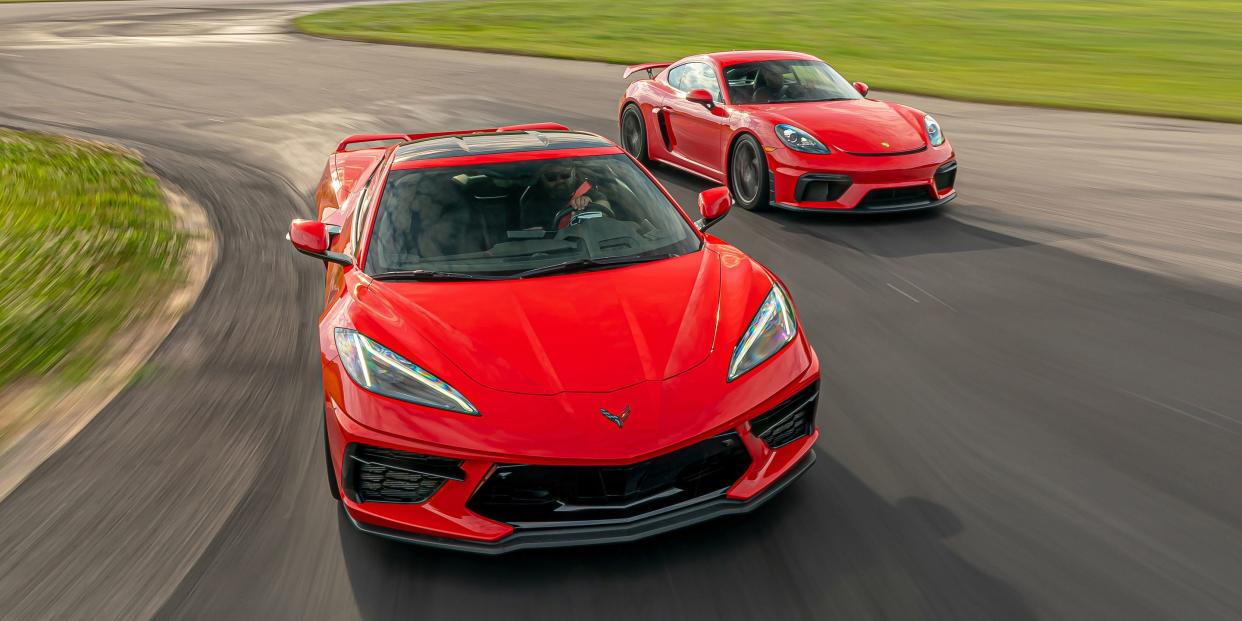

From the September 2020 issue of Car and Driver.
For the lot of you who have yelled at and/or addressed the editors of this magazine with a stern tone because we have not compared the new Corvette with the equally new 911, we hear you and we're choosing to ignore you.
The truth is that the Corvette's closest competitor from Porsche's lineup hasn't been the 911 for some time. The German brand made its rear-engine flagship just a bit too soft right as Chevrolet got downright serious about making big performance gains by relocating the Corvette's V-8. The mid-engine 718 series of two-seaters has taken the throne at Porsche as the de facto sports-car line while the 911 has realized the 928's goal of being the ultimate sports tourer.
Every few years, Porsche turns the knobs here and there to create a sharper 911 or a smoother Cayman, but the pointy end of performance has always been the GT cars. And the Cayman GT4 is the first 718 that Porsche clearly gave more bite than a 911.
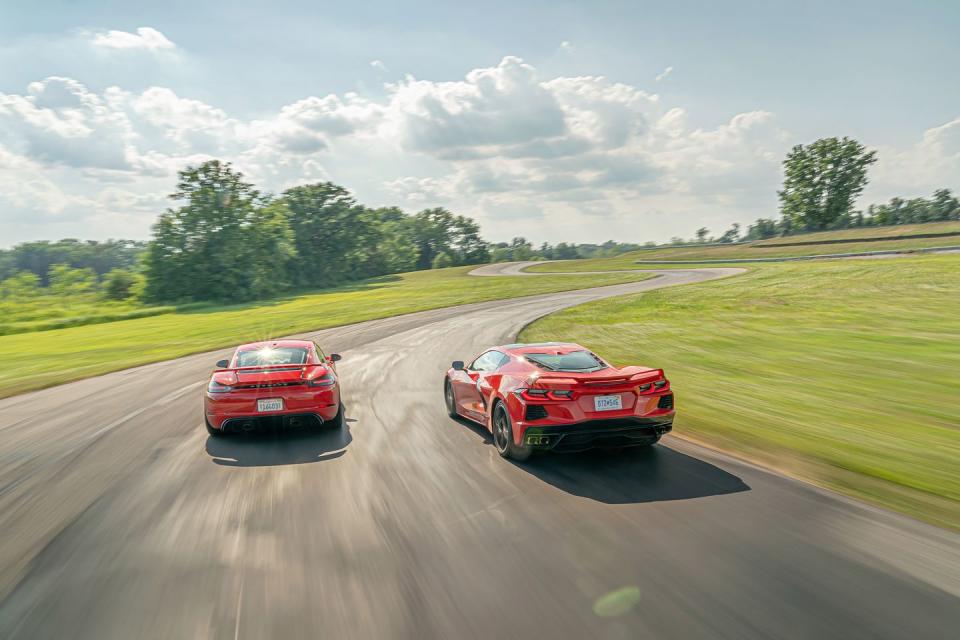
There are other reasons for this matchup, too: Both the V-8 in the Corvette and the flat-six in the Cayman GT4 are naturally aspirated, both cars locate their engines behind their cabins and within their wheelbases, and each has a stock chassis that gives track-day junkies no need for modification. This is the new sports-car rivalry: a battle for mid-engine supremacy in the stretch-goal price range.
Bone-stock brilliance from Chevrolet starts at $66,890. That will get you a base Corvette Stingray with the $5000 Z51 performance package (five-horse bump to 495, upgraded brakes and suspension, electronically controlled limited-slip diff, among other things) plus the $1895 magnetorheological dampers. The remaining $19,820 worth of options on our test car is, for the most part, window dressing. The biggest chunk of that goes to the $11,950 3LT package, which wraps the Vette's interior in leather and microsuede. Red seatbelts and brake calipers, a roof panel with exposed carbon fiber, an engine appearance package, Competition Sport seats, and carbon-fiber interior trim account for the rest.

The Cayman GT4 starts at $100,550, and this Guards Red example stickers for $105,230. Heated seats, automatic climate control, Apple CarPlay integration, and auto-dimming mirrors make up just over half the options cost. The other $2320 nets a navigation system. That makes this 414-hp GT4 about as close to a no-option car as it gets in the Porsche universe.
A loaded Corvette and a stripped-down GT4 costing nearly $20,000 more set up the classic conundrum of pricier import versus high-value American. Though, after spending some time with both, we can emphatically tell you there is no loser here. A day of road driving and a day at the thrilling 1.9-mile Grattan Raceway in either of these vehicles is the stuff of dreams. Sure, we've ranked the cars, but try to think of the results more as first and second winners.
2nd Place:
2020 Chevrolet Corvette Stingray Z51
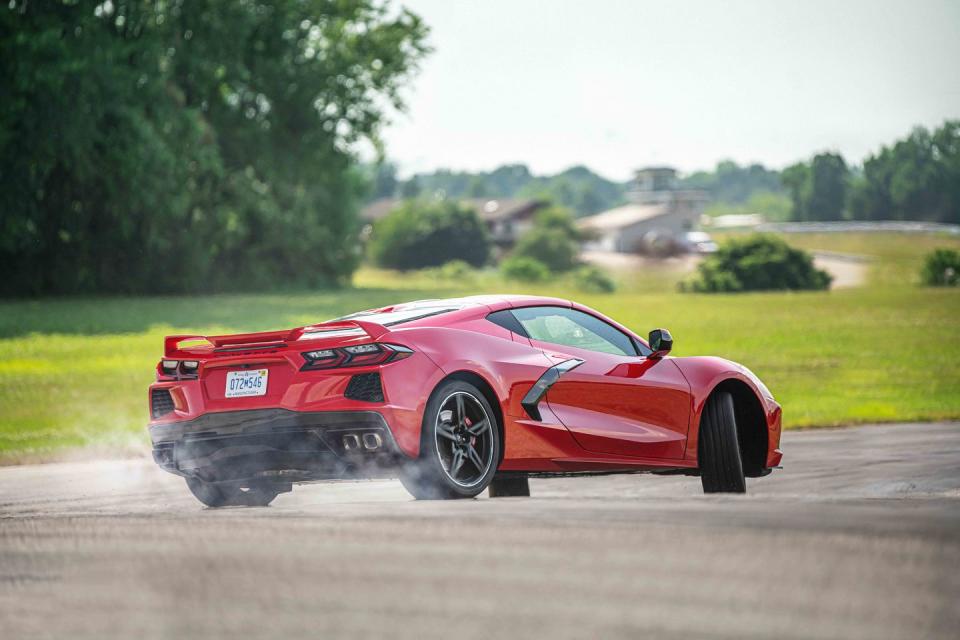
Highs: Lays down brag-worthy numbers, draws every eye, amazing value.
Lows: Feels cold next to its competition, claustrophobic cabin, where's the V-8 roar?
Verdict: The best Vette ever just isn't good enough to beat this Cayman.
If you have any doubt as to the mid-engine Corvette's appeal, take this nugget to the bank: When an acquaintance asked us what we thought of the C8, we told him to jump in his Robinson R44—a four-seat helicopter—and meet us at Grattan to find out for himself. We offered this invitation half on a lark because we knew he had the chopper. But his response of, "You sure I can land on the property?" followed by his appearance on test day only reinforced what we already know: Everyone loves a new Corvette.
Including us. This is a 10Best car. The Corvette is quicker than the GT4 around Grattan and in a straight line—three seconds flat to 60 mph, 11.3 seconds in the quarter-mile. It pulls 1.03 g's on the skidpad and stops from 70 mph in 154 feet. This car is definitely not the second winner because of its numbers. It earned silver because of how it feels when making those numbers.

With a 9.4-inch-longer wheelbase and 5.2-inch-wider body than the GT4, the Corvette drives huge in comparison. That feeling is further exaggerated by the Stingray's 3638-pound curb weight, which is 427 pounds more than the Cayman's. On paper, the Corvette's cabin is two cubes bigger than the GT4's, yet it's the Porsche that feels airier, likely due to its low beltline and narrow center console.
The Corvette's impressive performance—you'll notice a lot of highlighting on its side of the results chart—helped the Chevy run a tenth of a second quicker around Grattan, but the car also felt antiseptic on track. It's as if the Corvette sold its soul for performance. There's a sort of unresolved Goldilocks thing going on with the steering: We can't find a driving mode we like, as Tour is too light, Track is too heavy, and yet Sport is not just right. Plus, there's so little feedback that the noise from the Michelin Pilot Sport 4S tires is more informative than the steering feel. And while the Cayman lapped Grattan without issue in 90-plus-degree heat, the Corvette's otherwise obedient eight-speed dual-clutch transmission suffered from a few bobbled shifts during the hottest part of the day.

We also couldn't ignore the Vette's build-quality issues, although we should note that this example was an early production unit. Neither the front nor rear bumper on our test car aligns very well with the body, and the panel gaps around the frunklid are uneven.
Don't let this criticism fool you; the Corvette is great. It is easy to drive and very quick, and it can transport two sets of golf clubs in its trunk and then beat everyone home from the 19th green. Why it is the second winner comes down to feelings. The Vette generates a lot of good ones, but the other car here generates even more.
1st Place:
2020 Porsche 718 Cayman GT4
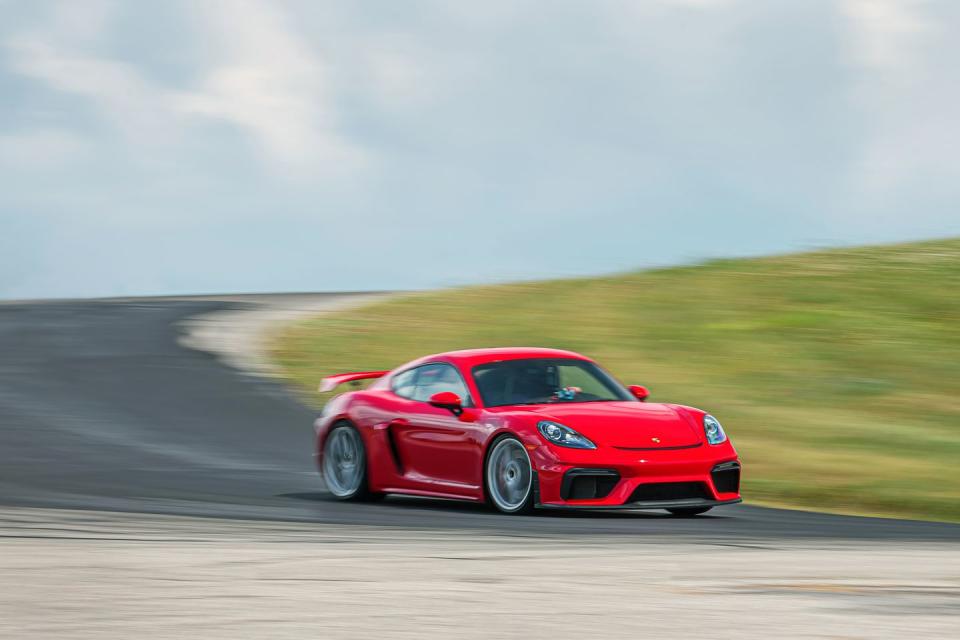
Highs: All the feels, flat-six soundtrack at 8100 rpm, surprisingly comfortable.
Lows: Nearly 20 grand is a big difference, is there a GT4 Touring without the wing?
Verdict: A near perfect automobile.
Going into this test, our pre-game bench racing suggested that the GT4 didn't have a shot. We've driven both cars before, and as we mentally filled out a ballot, we realized the 718 would need a clean sweep of the subjective categories to win. And there was no way the Cayman could compete with the Corvette's luxury-car ride, we thought.
But the GT4 rides better than we remembered and the Corvette rides worse, likely due to the suspension being set up for track duty. Plus, this Vette's Competition Sport seats have firmer cushions than the GT2 seats in the other C8 we drove, and this Cayman's standard sport seats are softer than the carbon-fiber buckets in the last GT4 we tested. Those differences effectively narrow the ride-comfort gap to nothing.
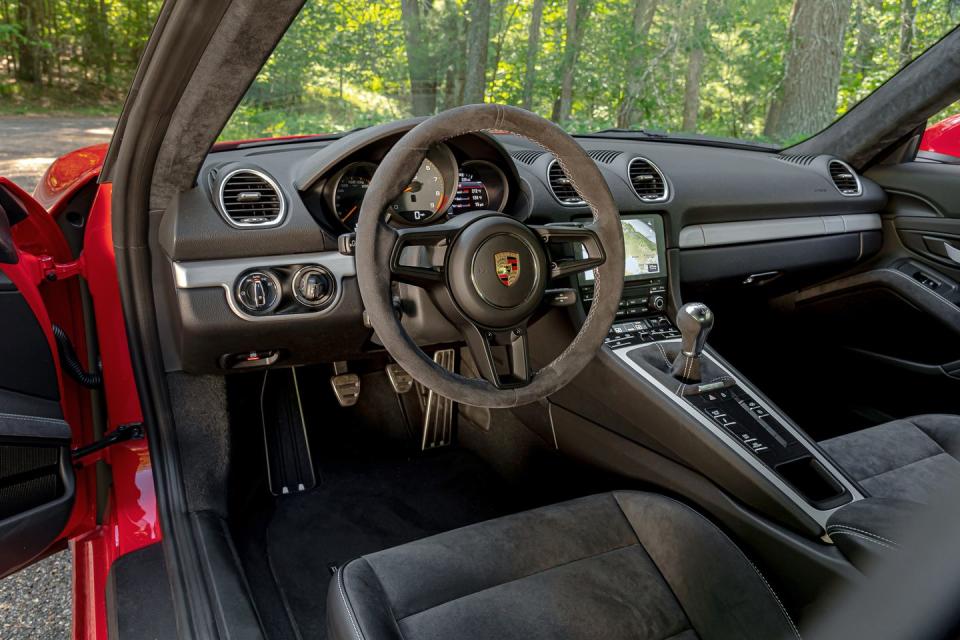
Borrowing suspension bits from the previous-generation 911 GT3 has its pluses and minuses. Metallic noise from the GT4's ball-jointed links surely contributes to the 77-decibel cruise—four decibels louder than the Corvette is at 70 mph. It's a trade-off we'd make most days because those precision bearings bolster the work that the Michelin Pilot Sport Cup 2 tires do to haul the car down from 70 mph in 149 feet and claw around the skidpad at 1.08 g's.
Those ball joints are also a boon to chassis feedback. The Cayman's Alcantara-wrapped steering wheel, which has no buttons and is comfortingly round, provides the driver with terabytes of information while linking turns with surgical precision. It makes for a stark contrast with the Corvette's squared-off, button-laden, and relatively uncommunicative helm.
There is a fundamental difference in the balance of these cars. Both hold their own on a back road, but when you get to the limit on a racetrack, the Porsche is more neutral. This is very evident on the greasy Grattan tarmac. The Corvette pushes in places where the Cayman's tail wags with fair warning.
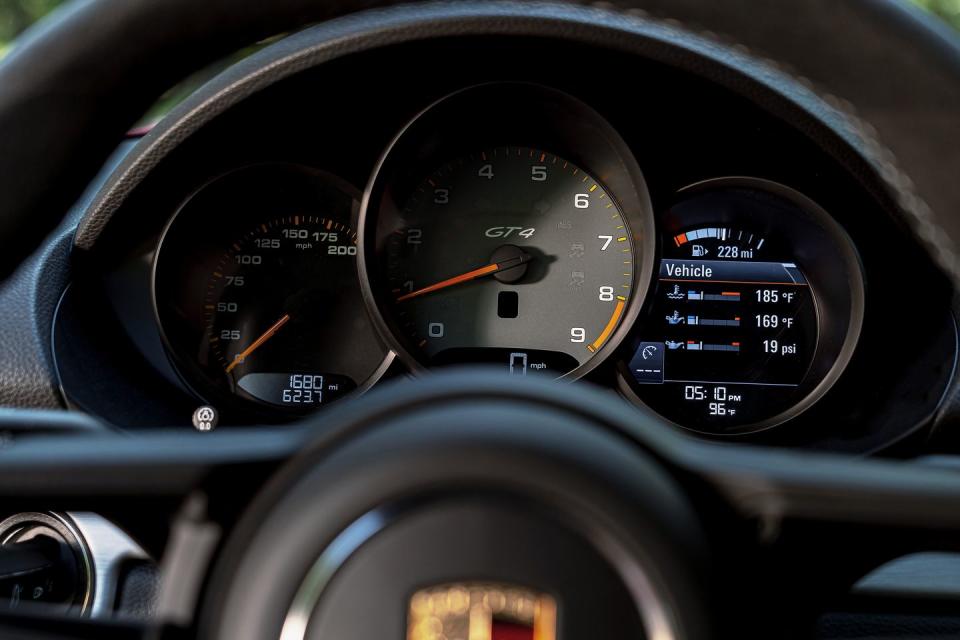
Anyone who tells you they prefer driving an automatic hasn't wielded the magical six-speed in this GT4 at its 8100-rpm redline. The shifter's short throws tuck into gear with just the right snap. The 4.0-liter flat-six doesn't make quite the same shriek as the 4.0 in the 911 GT3, but it's close enough to make you forget that the engine is a little dull at low revs. It's also considerably louder than the Corvette's V-8, which GM toned down a lot for the C8. "I guess there's a radio in here?" said technical editor David Beard about the Porsche. "I can get lost in this thing pretty easily." The GT4 also gets lost in the crowd, which we think can be a good thing after spending a weekend explaining to gawkers that the C8 isn't a Ferrari.
We drive a lot of cars, and there isn't one in recent memory that is as good in the corners as this Cayman is and still comfortable enough to drive daily. A GT4 without the boy-racer wing would be even better. Beating the cheaper, quicker, more powerful Corvette is a feather in its cap, and we suspect it's going to collect a lot more. There is little doubt in our minds that, dollar for dollar, this is the best car of 2020, but it is also one of the best and purest sports cars Porsche has ever made.
Dead Heat
Chevrolet Corvette Z51 ........... 1:26.4
Porsche 718 Cayman GT4 ....... 1:26.5
Grattan is a tight 1.9-mile course that rewards patience. On our day of lapping, it was well over 90 degrees and the track was very greasy. Given that, these aren't the fastest laps on record, but they are comparable.

A. The GT4 peaked on the straight at 138.7 mph; the C8, at 138.6. The greasy surface made braking into Turn 1 tricky. As we pushed the braking point a few feet farther, we found both cars nearly out of control. Backing off a few feet on the next lap felt like we had slowed way too soon. We got it right on the Vette's fast lap, giving the Chevy an early lead.
B. In this off-camber downhill blind left, the GT4's more neutral balance helps it turn a little better and get up the hill quicker, making up what was lost in the braking zone on the front straight. Lateral acceleration is about the same for both cars here, at 1.06 g's, but the Cayman pulls harder on the exit.
C. After the jump, the right-left-right-left-looooong-right combination is essentially a wash. The GT4 carries a little more speed at the apexes, but that's countered by the Vette's thrust. And the GT4 is caught between gears before the carousel-like Turn 8. Second gear is needed, but it'd be nicer to stay in third to prevent another downshift.
D. The GT4 just barely wins the sprint to the slowest corner with a 104.0-mph peak to the C8's 103.0. The wait through this roughly 35-mph turn is torturous; neither car feels in its element going this slow.
E. The GT4 soaks up the reverse corkscrew—a right-left climb with a big dip at the apex of the initial turn—much better than the C8. Then it's a dead-even drag race down the straight.
F. We suspect the Corvette's fractional lead at the finish line would widen at cooler temperatures, as its more street-friendly Michelin Pilot Sport 4S rubber felt more compromised by the heat than the Cayman's Pilot Sport Cup 2s. We will have to wait for Lightning Lap to see which is definitively quicker on a track.

You Might Also Like

 Yahoo News
Yahoo News 
